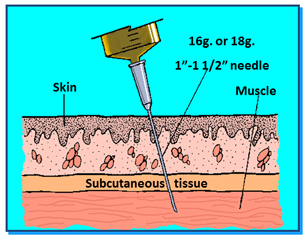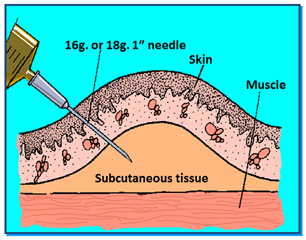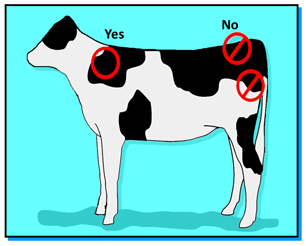G2159
Good Management Practices for Youth
Injections
As a good and responsible livestock producer, you are providing excellent care for your animal on a full-time basis. Below are sound production practices to help your animal thrive in your care. In addition, a checklist has been provided to make sure you follow these guidelines prior to and while at fairs and other public exhibitions.
This is No. 4 in a series of seven documents on good management practices for youth. Copies of these documents, commonly asked questions, feed and water requirements, and many other animal care and well-being documents can be accessed at http://4h.unl.edu/resourceanimalcare.
Lindsay M. Chichester, Extension Educator
Dennis E. Bauer, Extension Educator
|
Prior to Fair
If your animal requires medication, it is important to read and follow all label directions or instructions from your veterinarian. The label will tell you where and how to give the product. For example, the label will say whether an injection should be given intramuscularly (in the muscle) or subcutaneously (under the skin). The label also may recommend the proper needle length.
Make sure that the medication/vaccine you are using has been stored properly at the correct temperature. Some medications have a recommended withdrawal period that must be followed. It is very important that as a livestock producer, you abide by the withdrawal periods to ensure all medication is out of your animal’s system at harvest.
If your animal requires an injection, the proper injection site is in its neck (pigs, sheep, and cattle), in front of the shoulder. In addition, you should always use a clean syringe and a clean, sharp needle. If the integrity of your syringe or needle has been compromised, the injection site could become severely infected and cause additional problems for your animal.
If a needle breaks, it is very important to make sure that none of the broken needle remains in your animal, as it could potentially end up in the food supply. You would not want a piece of needle in your steak or roast, so do not allow someone else to experience it!
It is very important that you record the date of the injection, the animal name or ID number, the medication used, the type of treatment, the location of the injection (e.g., neck), the amount of medicine injected, the withdrawal date,
and any comments/observations. These treatment records should be taken to all fairs and exhibitions.
As a good youth producer, I know that prior to fair my animal has received:
- an accurate and quick diagnosis of disease from a veterinarian, leader, or parent/guardian,
- a treatment plan (if applicable),
- proper treatment, and
- post-treatment observation.
If an injection is needed:
- ensure the medication/vaccine has been stored properly,
- use a clean syringe and a clean, sharp needle,
- use an appropriate gauge needle of the correct length,
- use a medication/vaccine that meets the withdrawal times you desire,
- follow the label recommendation (subcutaneous/intramuscular) for administration, and
- ensure all injections given to pigs, sheep, and cattle are in the neck of the animal.
 |
 |
|
| Intramuscular Injection | Subcutaneous Injection |
While at Fair
If you have to treat your animal prior to the fair or while at the fair, you must tell a fair official immediately. If the show is terminal, it will be important to determine if your animal is still eligible. If the medication has a long withdrawal time, you may have to take your animal home until the required time has passed so your animal is safe to consume.
As a good youth producer, I know that at fair my animal has received:
- an accurate and quick diagnosis of disease from a veterinarian, leader, or parent/guardian (if applicable).
If an injection is needed:
- ensure the medication/vaccine has been stored properly,
- ensure proper, safe restraint is provided for the animal,
- ensure a clean syringe and a clean, sharp needle are used,
- ensure the needle length is appropriate,
- ensure the medication/vaccine meets the correct withdrawal time,
- ensure the medication is given via the method recommended on the label (subcutaneous/intramuscular),
- ensure all injections in pigs, sheep, and cattle are given in the neck of the animal, and
- notify a fair official that your animal has received an injection (the withdrawal time may need consideration prior to a terminal sale).
By following these guidelines prior to and during fairs and exhibitions, you can minimize stress for both you and your animal. In return, your animal not only will perform better but also will behave better. You will have the satisfaction of knowing that you have provided the best possible care for your animal.
Annually, Nebraska’s youth are required to complete Quality Assurance (QA) training. Quality Assurance is a program that educates youth about the best management practices for livestock production. In addition, it was developed to assure consumers that the food products produced from animals are wholesome and safe, and that the animals that produced the product were cared for properly. In 2012, this training also was made available online for 4-H and FFA members at three different age levels: Junior (8-10); Intermediate (11-14); and Senior (15-18). More information about the Nebraska Youth QA Program can be found at http://4h.unl.edu/qualityassurance.
This publication has been peer reviewed.
Visit the University of Nebraska–Lincoln Extension Publications website for more publications.
Index: Animals, General
Management
Issued June 2012
